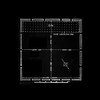Previous Lecture | Next Lecture
Concepts
The House and Mosque of the Prophet at Medina: The Islamic prototype of both religious and residential architecture, built in 622 C. E. (1 A.H. or After Hegire, the emigration of the Prophet to Medina), and enlarged several times in the first century of Islam, the most important of which is the enlargement of al-Walid, the Umayyad caliph, in 707.
The Early Congregational Mosques of the Amsar
Misr: Name of early Islamic garrison towns, founded in the conquered regions. The most famous amsar (plural of misr) were Busra and Kufa in Iraq, Fustat in Egypt, and Qayrawan in Tunisia. These settlements grew from informal encampments around a central mosque to capital cities within the first century Hegire (7th-8th century C. E.).
- The Mosque of Basra in Iraq (635, rebuilt 665).
- Other Early Examples of Mosques in Bosra, South Syria (late 7th c.).



